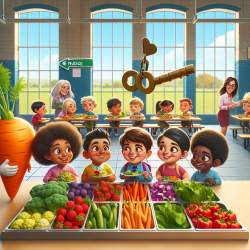Introduction
In the pursuit of healthier eating habits for children, schools have become a focal point for interventions aimed at increasing fruit and vegetable consumption. The recent study, "Implementation of a Multi-Component School Lunch Environmental Change Intervention to Improve Child Fruit and Vegetable Intake: A Mixed-Methods Study," sheds light on effective strategies to achieve this goal. This research, published in the International Journal of Environmental Research and Public Health, explores the potential of nudge interventions in school cafeterias to promote healthier eating behaviors among children.
The Study at a Glance
The study implemented a multi-component intervention in three rural elementary schools in Illinois. The interventions included cafeteria decorations, creative names for fruits and vegetables, social norming taste tests, and flavor stations. Over eight months, the researchers assessed the selection and consumption of fruits and vegetables through monthly plate waste assessments. The results were promising, showing increased fruit consumption and improved odds of vegetable selection during certain intervention months.
Key Findings and Implementation Insights
Here are some of the study's key findings and insights for practitioners looking to implement similar interventions:
- Creative Names and Cafeteria Decorations: These interventions were found to be highly acceptable and feasible, particularly when students were involved in creating names and decorations. Schools reported increased fruit consumption during these intervention months.
- Social Norming Taste Tests: This component showed high acceptability and feasibility, leading to increased vegetable selection. The taste tests involved students trying new vegetable recipes and voting on their willingness to try them again, fostering a positive social norm around vegetable consumption.
- Flavor Stations: Offering spices and seasonings for students to customize their meals was another effective strategy. It gave students autonomy over their food choices, encouraging them to try and enjoy vegetables more.
Challenges and Considerations
While the interventions showed promise, the study also highlighted challenges such as resource limitations and varying acceptability across different school environments. Practitioners should consider these factors and tailor interventions to their specific school settings. Engaging school staff and leveraging external support, such as partnerships with extension services, can enhance the feasibility and sustainability of these interventions.
Conclusion
Nudge interventions present a low-cost, effective strategy to improve children's dietary behaviors in school settings. By understanding and addressing the implementation challenges, schools can create environments that promote healthier eating habits. Practitioners are encouraged to explore these strategies and consider further research to optimize their implementation and impact.
To read the original research paper, please follow this link: Implementation of a Multi-Component School Lunch Environmental Change Intervention to Improve Child Fruit and Vegetable Intake: A Mixed-Methods Study.










